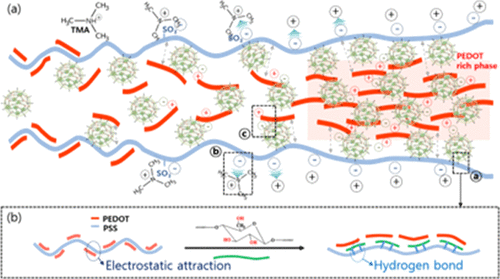当前位置:
X-MOL 学术
›
ACS Appl. Polym. Mater.
›
论文详情
Our official English website, www.x-mol.net, welcomes your
feedback! (Note: you will need to create a separate account there.)
Highly Stretchable Conductive Nanocomposite Films Using Regenerated Cellulose Nanoparticles
ACS Applied Polymer Materials ( IF 4.4 ) Pub Date : 2020-09-17 , DOI: 10.1021/acsapm.0c00294 Soon Mo Choi 1, 2 , Sung Soo Han 1, 2 , Eun Joo Shin 3
ACS Applied Polymer Materials ( IF 4.4 ) Pub Date : 2020-09-17 , DOI: 10.1021/acsapm.0c00294 Soon Mo Choi 1, 2 , Sung Soo Han 1, 2 , Eun Joo Shin 3
Affiliation

|
Dip-coating or printing methods are often used to fabricate conductive composite films using organic polymeric conducting fillers to achieve high performance, but these approaches are prone to friction. To overcome this, anionic waterborne polyurethane (WPU)-based conductive nanocomposite films were developed in this study by drop-casting. Regenerative cellulose nanoparticles (RCNs) were incorporated as a chain extender and reinforcing filler to enhance both the mechanical and electrical properties. The loading of RCNs into the anionic WPU is not only an environmentally friendly approach using biomass but also a smart one producing poly(3,4-ethylenedioxythiophene) (PEDOT)-rich domains, thereby enhancing its conductivity. Moreover, the elasticity of the fabricated films increased with increasing Young’s modulus and by the introduction of RCNs with low crystallinity. These findings highlight the importance of PEDOT assisted by anionic WPU with RCNs in achieving conductive WPU/RCN nanocomposite films dispersed with PEDOT with an enhanced electrical conductivity of 1.16 × 10–1 and a high stretchability of 810 ± 17%.
中文翻译:

使用再生纤维素纳米粒子的高拉伸导电纳米复合薄膜
浸涂或印刷方法通常用于使用有机聚合物导电填料来制造导电复合膜,以实现高性能,但是这些方法容易产生摩擦。为了克服这个问题,本研究通过滴铸技术开发了基于阴离子水性聚氨酯(WPU)的导电纳米复合薄膜。掺入了再生纤维素纳米颗粒(RCN)作为增链剂和增强填料,以增强机械和电气性能。将RCN装载到阴离子WPU中不仅是使用生物质的环保方法,而且是一种生产富含聚(3,4-乙撑二氧噻吩)(PEDOT)的结构域的聪明方法,从而增强了其导电性。此外,随杨氏模量的增加和低结晶度RCN的引入,制成膜的弹性增加。这些发现凸显了带有RCN的阴离子WPU辅助PEDOT在获得分散有PEDOT的导电WPU / RCN纳米复合膜中的重要性,其导电性提高了1.16×10–1和810±17%的高拉伸性。
更新日期:2020-11-13
中文翻译:

使用再生纤维素纳米粒子的高拉伸导电纳米复合薄膜
浸涂或印刷方法通常用于使用有机聚合物导电填料来制造导电复合膜,以实现高性能,但是这些方法容易产生摩擦。为了克服这个问题,本研究通过滴铸技术开发了基于阴离子水性聚氨酯(WPU)的导电纳米复合薄膜。掺入了再生纤维素纳米颗粒(RCN)作为增链剂和增强填料,以增强机械和电气性能。将RCN装载到阴离子WPU中不仅是使用生物质的环保方法,而且是一种生产富含聚(3,4-乙撑二氧噻吩)(PEDOT)的结构域的聪明方法,从而增强了其导电性。此外,随杨氏模量的增加和低结晶度RCN的引入,制成膜的弹性增加。这些发现凸显了带有RCN的阴离子WPU辅助PEDOT在获得分散有PEDOT的导电WPU / RCN纳米复合膜中的重要性,其导电性提高了1.16×10–1和810±17%的高拉伸性。











































 京公网安备 11010802027423号
京公网安备 11010802027423号